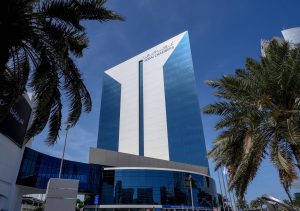
Data centres are essential for the growing digital world, yet they are one of the most energy-intensive building types, consuming 10 to 50 times per floor space more than that of a typical commercial office building. Water consumption is also majorly high, with some studies suggesting that a typical data centre might require as much as three to five million gallons per day, equivalent to the amount used by a city of 30,000-50,000 people! Reports also suggest that yearly energy consumption is growing, with an estimated share being between three and four percent of total electricity generated on earth and accounting for one percent of greenhouse gas emissions.
Whilst Data Centre’s do have an impact on the environment, its share of contributions has hardly changed since 2010, despite the number of internet users doubling and global internet traffic increasing fifteenfold. This has been possible as data centres reduce the total amount of power and the overall footprint of computing by aggregating demand from several locations into highly efficient, centrally managed cloud data centres, as opposed to being distributed across several buildings and offices which were far less efficient facilities.
Data centres have also become much more energy and water efficient over the last decade and consume less water than other industries such as agriculture. However, with data storage predicted to rise to 5.3 times its current figure by 2025, more needs to be done to further reduce carbon emissions in anticipation of the rapid growth of hyperscale cloud data centres across the world.
Green data centre design, construction, and operation
A green or sustainable data centre is a service facility where its mechanical, lighting, electrical, and computer systems are designed to maximise energy efficiency and minimise environmental impact, specifically its carbon footprint. To be truly sustainable, a data centre must be environmentally responsible throughout its entire life cycle – from design and construction, to operation and decommissioning. There are several different approaches to achieving a sustainable data centre while not compromising its reliability and performance.
- Use of sustainable construction methods and materials – When constructing a data centre, it is possible to minimise the associated embodied carbon by selecting materials that are sustainable and low-carbon. Recycled steel and concrete are two such options. Modular construction methods have also become increasingly popular, as they offer more flexibility in design and come in smaller increments.
- Adoption of advanced cooling technologies – Data centres use a great deal of energy to maintain optimal temperatures due to the heat generated by their servers. To reduce this energy consumption and improve cooling efficiency, advanced technologies such as liquid cooling, liquid immersion cooling, and evaporative cooling are being employed. Liquid cooling works by circulating water over the hot side of the cabinet to lower its temperature. Liquid immersion cooling involves immersing servers and other equipment in non-conductive liquids. Finally, evaporative cooling is a process that leverages the decrease in air temperature when water changes from liquid to gas, absorbing energy in the process and reducing electricity use for mechanical systems.
- Water conservation – Data centres use large amounts of water for cooling purposes. One way to reduce water consumption is to use greywater recycling systems which reuse wastewater from sinks/showers for toilet flushing or irrigation. Rainwater can also be harvested for use in data centre cooling. Amazon, Microsoft, and Google Cloud have all pledged to become water-positive, meaning they will make more water available than they consume.
- Use of renewable energy sources – Data centres are well-positioned to reduce their carbon footprint by transitioning to renewable energy sources, such as solar or wind power. Hydrogen and hydrotreated vegetable oil (HVO) can also be used as power sources, offering an effective alternative to diesel-powered generators. Whilst the technology needed for the large-scale transition of existing data centres is still in development, the sustainable benefits are vast.
- Capture and reuse of waste heat – The heat created from data centres can be employed to not only warm nearby office buildings (reducing the associated operational costs), but the excess heat generated can also efficiently be used to heat nearby residential areas.
- Improved IT efficiency – Data centres can also improve their energy efficiency by using more efficient servers and other IT equipment, as well as implementing power management techniques, such as server virtualisation and consolidation, a process which helps reduce energy consumption by consolidating multiple servers onto fewer physical machines.
Summary
As the world becomes more environmentally aware, it is important that data centre operators ensure their facilities are performing as efficiently, effectively, and as such, as sustainably as possible.
All of the world leading data centre operators remain committed to exploring new ways of improving data centre sustainability, as part of their strategies and efforts for becoming carbon neutral or carbon negative. Through investments and advancements of renewable energy sources and innovative technologies in cooling and operation, the data centre industry seems to be one of the industries at the forefront of its commitment to the environment, showing that great strides are being made in its journey to becoming carbon neutral.











